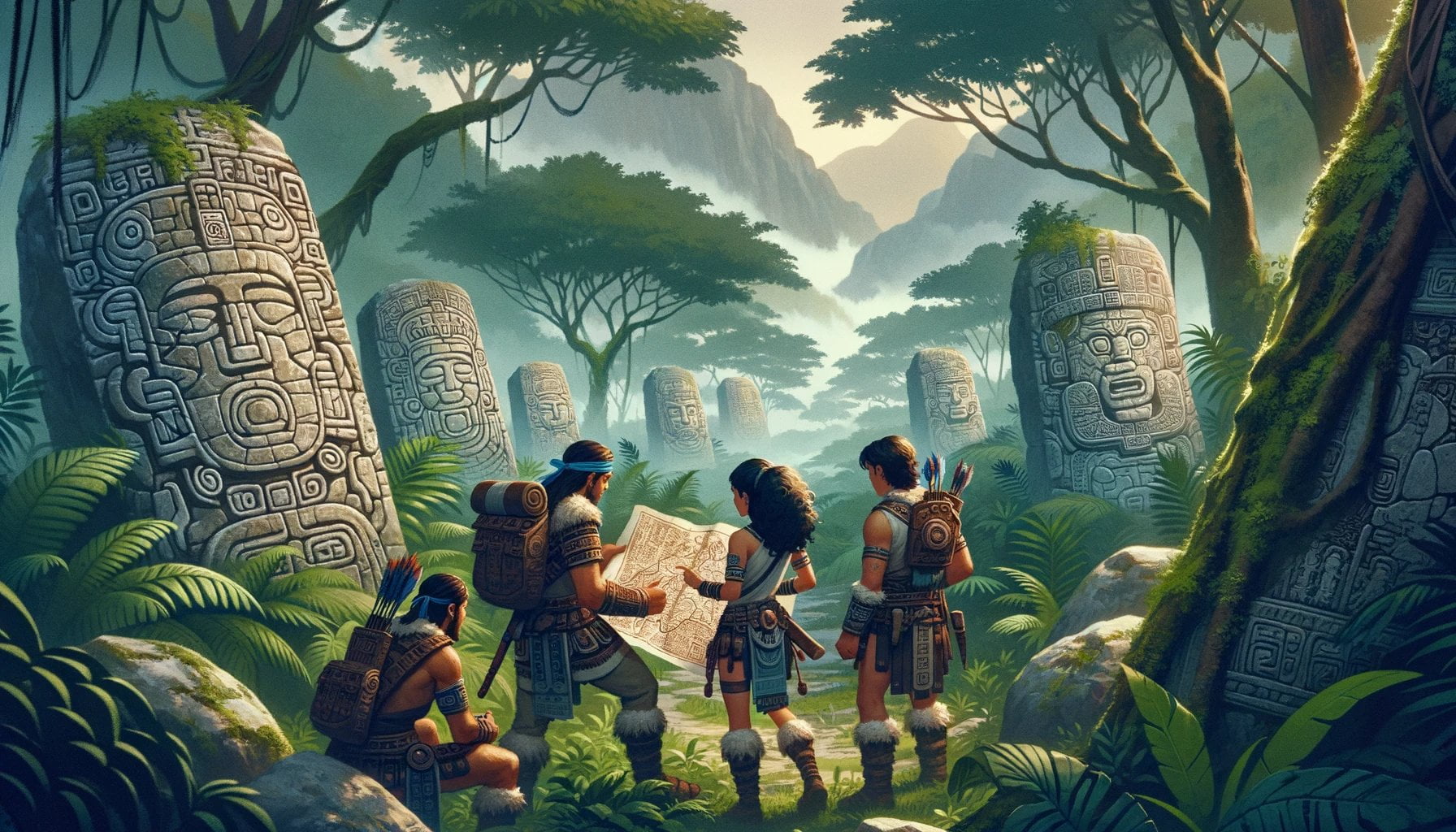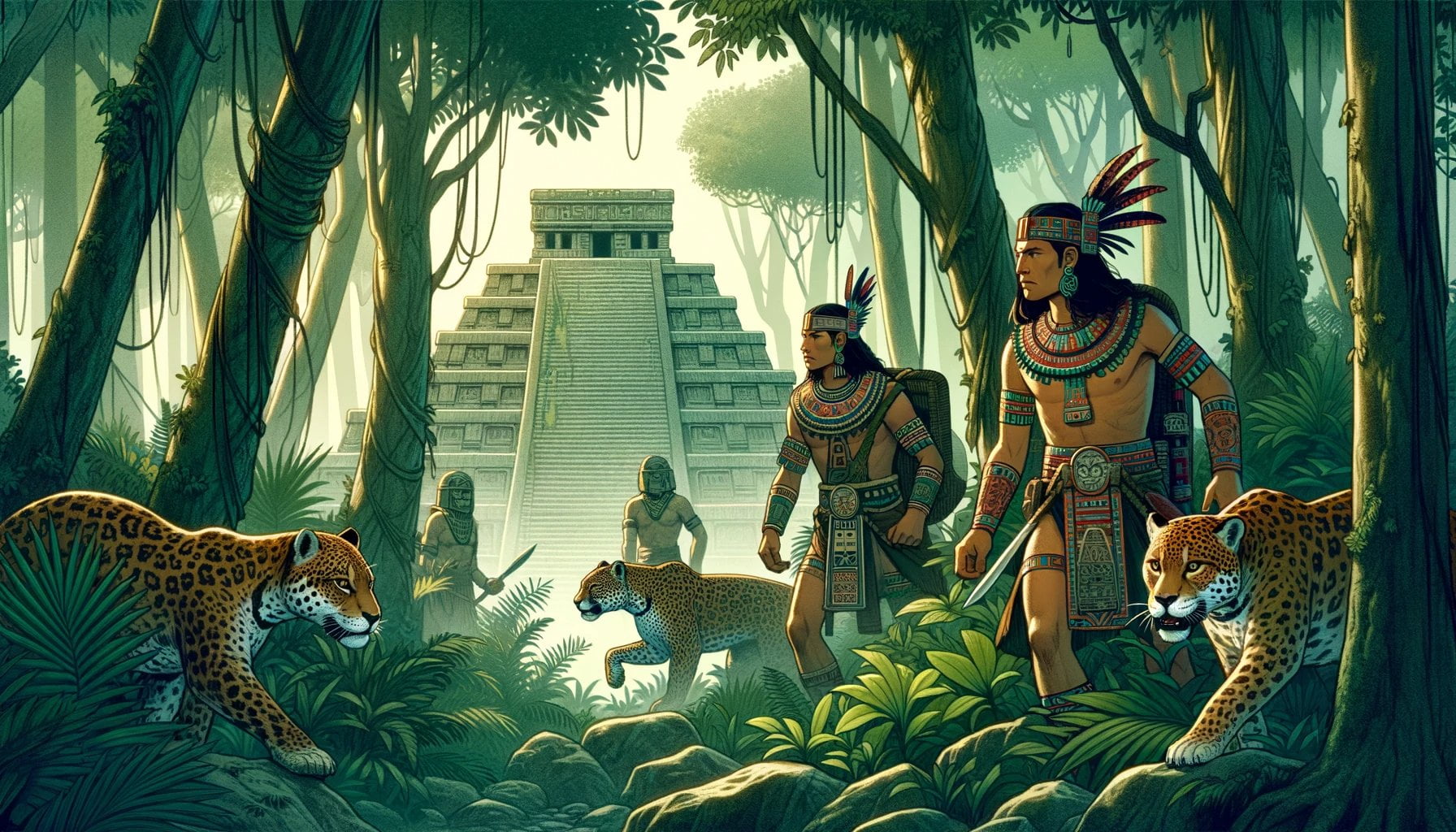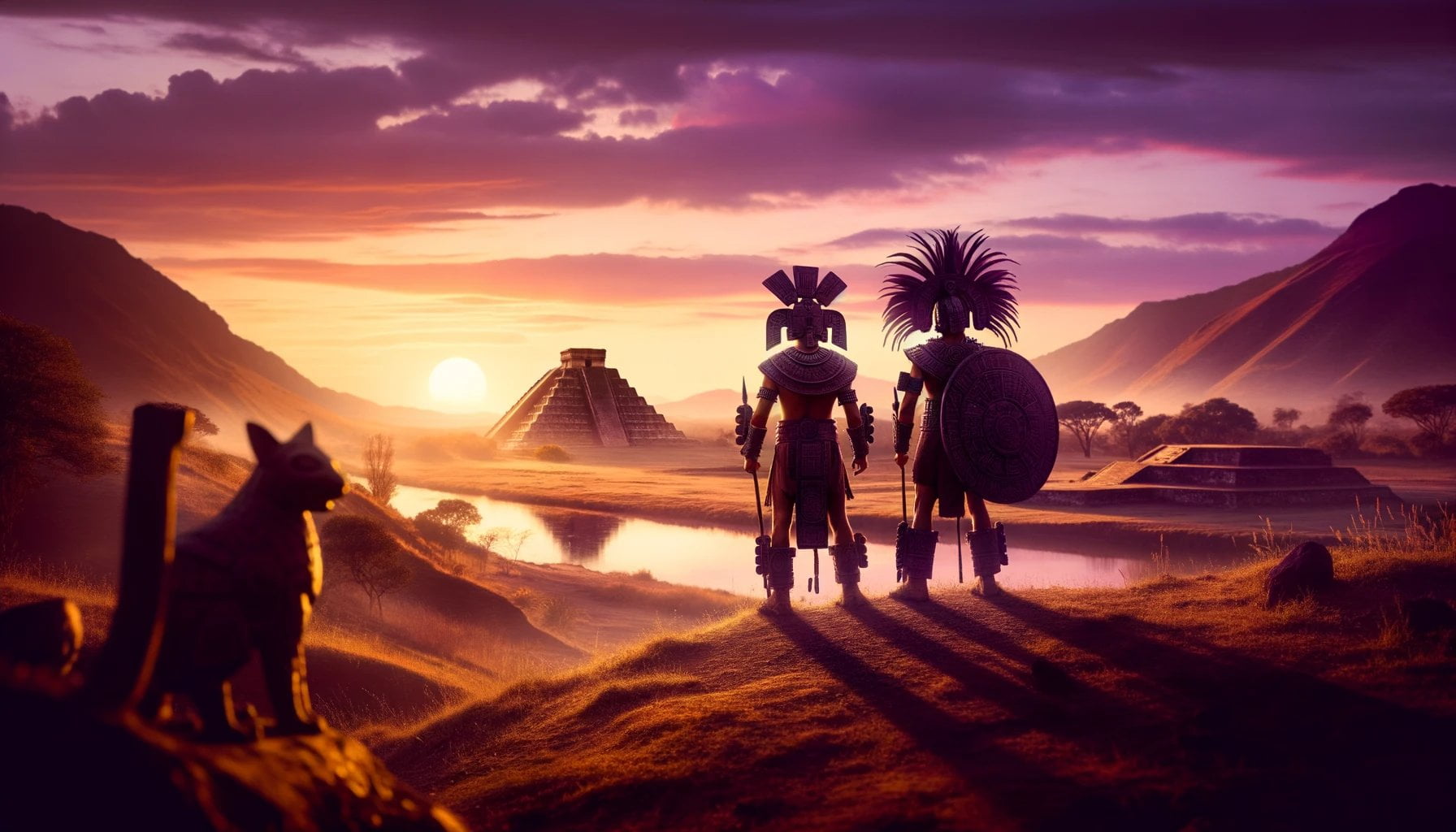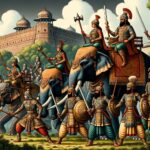Unveiling the Legacies of Ancient Mexican Warriors takes readers on a captivating journey through the rich history and profound cultural significance of these revered warriors. From the mighty Aztecs to the enigmatic Mayans, this article delves into the extraordinary prowess, intricate rituals, and enduring legacy of ancient Mexican warriors. With a passion for ancient civilizations and extensive research, the author brings their expertise to bear in crafting a comprehensive exploration of these formidable warriors and their indelible mark on Mesoamerican history.

Key Takeaways:
- The Aztecs were a Nahuatl-speaking people who ruled a large empire in central and southern Mexico in the 15th and early 16th centuries.
- The Aztec people emerged after the collapse of the Toltec civilization in the 12th century, according to their own traditions.
- Aztec warriors were highly esteemed and dedicated their lives to warfare.
- The Aztec armed forces were composed of commoners known as yāōquīzqueh, who were known for their discipline and ferocity in battle.
- Eagle warriors were elite Aztec warriors who had extensive military and martial arts training. They fought in ritualistic wars called “flowery wars.”
- The Mexica, a part of the Aztec civilization, had no standing army but had elite warriors who fought in “flowery wars” and captured victims.
- Mesoamerican civilizations developed glyphic writing systems to record their history, which spans over three millennia in Mexico.
- Aztec victory in warfare often came when they sacked the enemy’s main temple, showcasing their discipline and ferocity in battle.
Ancient Mexican Warriors
Unveiling the Legacies of Ancient Mexican Warriors
The rich and vibrant history of ancient Mexican warriors continues to captivate us, offering a glimpse into a world of bravery, honor, and conquest. These formidable warriors played a pivotal role in shaping the ancient cultures of Mexico, leaving behind a lasting legacy that still echoes through time. Let us embark on a fascinating journey, delving into the origins, traditions, and profound significance of these revered warriors.
Unraveling the Aztec Legacy
At the heart of ancient Mexican warrior culture lies the mighty Aztec civilization. Emerging after the collapse of the Toltec empire in the 12th century, the Aztecs became a dominant force in central and southern Mexico during the 15th and early 16th centuries^1^. Aztec warriors were revered and esteemed, dedicating their lives to the pursuit of warfare[^3^]. Composed mainly of commoners known as yāōquīzqueh, the Aztec armed forces were known for their discipline, ferocity, and unwavering dedication to battle^4^.
Elite Warriors and Sacred Rituals
Eagle warriors, the elite of the Aztec military, stood at the forefront of these ancient Mexican warriors. These skilled fighters underwent extensive military and martial arts training, making them formidable adversaries^5^. Their prowess and resilience were showcased in ritualistic wars known as “flowery wars,” where capturing victims played a significant role^6^. The Mexica, a faction of the Aztec civilization, had no standing army but instead relied on their elite warriors to defend their people and expand their influence^6^.
The Written History of Mighty Empires
To truly comprehend the legacy of ancient Mexican warriors, one must understand the historical context in which they thrived. The written history of Mexico stretches back over three millennia, chronicling the rise and fall of complex indigenous civilizations^7^. Mesoamerican cultures developed sophisticated glyphic writing systems, meticulously recording their history for future generations to unravel^7^. These invaluable texts grant us a rare glimpse into the traditions, rituals, and military strategies employed by the ancient Mexican warriors.
Victories and Temples
Victory for the Aztecs often came in the form of sacking the enemy’s main temple[^8^]. The disciplined and ferocious nature of Aztec warriors ensured their success on the battlefield[^8^]. As they triumphed in battle, they left an indelible mark on their enemies’ sacred spaces, solidifying their dominance and asserting their power.
In conclusion, the legacies of ancient Mexican warriors continue to captivate us with their tales of bravery, warfare, and cultural significance. The Aztecs and their elite eagle warriors have left an indelible mark on history, shaping the ancient civilizations of Mexico. As we unravel the secrets of their past, we gain a deeper understanding of the profound impact these warriors had on the world they inhabited. May their legacies endure and inspire generations to come.
[^3^]: Realm of History
[^8^]: World History Encyclopedia
In ancient Persia, there were numerous groundbreaking inventions that changed the course of history. From advanced irrigation systems to revolutionary postal services, the innovations of ancient Persia continue to amaze us today. Discover the incredible ancient Persia inventions and their impact on the world. Ancient Persia Inventions
Explore the remnants of ancient Greek castles and delve into the captivating tales of ancient warriors and mythical creatures. Uncover the architectural marvels and rich history of these ancient Greek fortresses. Embark on a journey to ancient Greece and learn more about the fascinating ancient Greek castle. Ancient Greek Castle
Venture into the realm of myths and legends with the ancient tale of the ancients. Dive into the mysterious world of gods, goddesses, and epic battles that shaped ancient civilizations. Discover the enchanting Myth of the Ancients and unravel the secrets that lie within. Myth of the Ancients
Travel back in time to ancient Britain, where legendary heroes roamed the land and epic battles were fought. Uncover the stories of courage, honor, and adventure as we explore the heroic figures that defined ancient Britain. Join us on a quest to discover the remarkable Heroes of Ancient Britain. Heroes of Ancient Britain
Weapons and Battle Strategies
Ancient Mexican warriors, particularly the Aztecs, were renowned for their formidable weapons and strategic military tactics. In this article, we will delve into the fascinating world of weapons and battle strategies employed by these revered warriors.
Aztec Weapons:
The Aztecs utilized a wide range of weapons, crafted with skill and precision. From simple hand-held tools to complex projectile weapons, each played a vital role in Aztec warfare. [Weapons and battle strategies] were honed to perfection, ensuring the warriors’ dominance on the battlefield.
- Macuahuitl: One of the most fearsome weapons in the Aztec arsenal was the macuahuitl. This wooden club was embedded with shards of obsidian, creating a devastating cutting edge. With a swing of this weapon, an Aztec warrior could incapacitate or even decapitate their opponent.
- Atlatl and Tlacochtli: Aztec warriors were skilled at using the atlatl, a spear-throwing device, to launch projectiles known as tlacochtli. These darts could pierce armor and inflict severe damage.
- Maquahuitl: The maquahuitl, similar to a sword, was crafted with obsidian blades embedded in a wooden frame. It was a versatile weapon that allowed warriors to strike swiftly and inflict deep wounds.
- Cuāuhchimalli: This long-range weapon, a type of sling, was used to hurl stones or other small projectiles at the enemy from a distance. It provided Aztec warriors with an effective means to engage opponents before hand-to-hand combat.
Battle Strategies:
Aztec warfare was not only about wielding powerful weapons. Well-defined battle strategies were essential for success on the battlefield. Here are some key strategies employed by the Aztec warriors:
- Intelligence Gathering: The Aztecs recognized the importance of strategic intelligence. They relied on comprehensive information about enemy cities to plan battles and campaigns effectively. Detailed knowledge of the enemy’s strengths, weaknesses, and defensive structures played a crucial role in achieving victory.
- Flower Wars: Flower wars were a unique form of ceremonial warfare among the Aztecs. These wars served multiple purposes: showcasing the warriors’ bravery, intimidating enemies, and acquiring captives for sacrificial ceremonies. Through these battles, the Aztecs demonstrated their military might and cultural significance.
- Coordinated Attacks: Aztec warriors were skilled in executing coordinated attacks, utilizing their training and knowledge. These attacks involved precise timing, overwhelming the enemy with a swift and synchronized assault. By isolating and overpowering specific units, the Aztecs were able to gain the upper hand in battle.
- Psychological Warfare: The Aztecs excelled at employing psychological warfare to demoralize their opponents. This included intimidating displays of wealth and dominance, such as the extravagant regalia worn by eagle warriors. The sight of these fierce warriors often instilled fear in the hearts of their enemies, giving the Aztecs a psychological advantage.
- Siege Warfare: The Aztecs employed siege warfare tactics to conquer enemy cities. They surrounded cities, cutting off supplies and communication, forcing the inhabitants to surrender. This strategy allowed the Aztecs to expand their political hegemony and assert their dominance over neighboring city-states.
Key Takeaways:
- Aztec warriors wielded a variety of deadly weapons, including the macuahuitl, atlatl, and cuāuhchimalli.
- Strategic intelligence played a vital role in Aztec warfare, enabling effective battle planning and execution.
- Flower wars served as demonstrations of power, intimidation tactics, and opportunities to capture sacrificial victims.
- Coordinated attacks and siege warfare were key strategies employed by the Aztecs to achieve victory.
- Psychological warfare played a profound role in Aztec warfare, instilling fear and demoralizing their opponents.
Sources:
– Wikipedia – Aztec warfare
– Ancient History Encyclopedia – Aztec Warfare
Rituals and Religious Beliefs Related to Warfare
Key Takeaways:
- The Aztec-Mexica people of Tenochtitlan had a strong connection between their collective identity and military ideals.
- Aztec religion incorporated ritual practices, including ceremonial warfare and human sacrifice.
- Understanding the rituals and religious beliefs related to warfare is crucial in comprehending the conjunction of religion and war in Aztec society.
The Aztec-Mexica people of Tenochtitlan were known for their “warlike” culture, where their collective identity was closely tied to military ideals and behaviors. In order to fully understand the ancient Mexican warriors, it is important to explore the rituals and religious beliefs related to warfare that were prevalent in their society.
The Aztec religion played a significant role in shaping the rituals and religious beliefs surrounding warfare. Ceremonial warfare and human sacrifice were fundamental practices within their religious framework. These rituals were believed to be necessary for pleasing the gods and maintaining the order of the universe. Warriors were seen as agents of the gods, and their actions on the battlefield were regarded as sacred and influenced by higher powers.
Ritualistic warfare, often referred to as “flowery wars,” had a profound impact on the Aztec society. These battles were more ceremonial rather than purely strategic, serving to showcase the bravery and resilience of Aztec warriors. The primary objective of these battles was to capture sacrificial victims rather than complete annihilation of the enemy. Through these rituals, the Aztecs aimed to intimidate their enemies and solidify their own position as a dominant force in Mesoamerica.
In Aztec religion, warfare was intricately connected with their beliefs in Tenochtitlan. The city itself was considered a sacred place, built upon an island where it was believed that the gods had instructed the Aztecs to settle. The protection and expansion of Tenochtitlan were intertwined with their military actions, driven by the belief that their success in war was a testament to their divine support. Victories often involved sacking the enemy’s main temple, which would bolster their religious standing and secure the favor of the gods.
The Aztec religion was a complex system of beliefs, rituals, and gods that helped the Aztecs make sense of their physical reality and understand life and death. They believed in a multiple-deity universe, with different gods governing various aspects of Aztec society. These deities represented concepts such as war, fertility, and agriculture, and their worship was ingrained in every aspect of Aztec life, including warfare.
In conclusion, the rituals and religious beliefs related to warfare played a fundamental role in the worldview of the ancient Mexican warriors, particularly the Aztecs. These rituals were deeply intertwined with their religious practices, shaping their understanding of war and their position in society. By exploring the rich tapestry of rituals and religious beliefs, we can gain a deeper appreciation for the profound cultural significance of ancient Mexican warriors.
Sources:
– Taylor & Francis Online
– Wikipedia
Legacy and Influence of Ancient Mexican Warriors
Key Takeaways:
– Ancient Mexican warriors, particularly the Aztecs, left a lasting legacy and had a significant influence on Mexican history.
– The Aztec warriors, known for their bravery and dedication to warfare, played a crucial role in expanding the Aztec empire and acquiring tribute from conquered tribes.
– Their military achievements contributed to the Aztecs’ economic prosperity and religious practices, including the acquisition of sacrificial victims.
– The training and rituals undergone by Aztec warriors, such as the Telpochcalli, showcased the importance of warfare in Aztec society.
– The Mexica, a faction of the Aztec civilization, relied on their elite warriors, including the eagle warriors, for defense and expansion.
– The legacies of ancient Mexican warriors continue to inspire and inform our understanding of history and the cultural significance of warfare.
The Aztecs, a group of Nahuatl-speaking people, held an esteemed position in the ancient Mexican civilizations. Their prominent warrior society and advancements in warfare left a profound legacy that continues to influence Mexican history to this day[^1^].
Warfare was deeply ingrained in Aztec society, and becoming an Aztec warrior was no easy feat. Similar to the ancient Spartans, the Aztecs believed that war was a fundamental pillar of their civilization[^2^]. The training of future warriors, known as Telpochcalli, commenced at a young age, shaping their formidable abilities and dedication to combat[^3^].
The Aztec military operated under a merit-based system, valuing the esteemed warriors who dedicated their lives to warfare. Their accomplishments in battle earned them wealth and respect among their people[^4^]. Victories in war allowed the Aztecs to expand their territory, acquire tribute from conquered tribes, and provide sacrificial victims for their religious ceremonies[^5^].
Despite the decline of the Aztec civilization, the legacy of their warriors perseveres. The Aztec warriors, known for their fearsome reputation and cruelty in battle, played a vital role in both the economy and religion of the Aztec empire[^6^][^7^]. Their influence and impact on Mexican history cannot be overstated, as their military traditions and cultural significance continue to shape our understanding of ancient civilizations[^8^].
To delve deeper into the history and legacy of Aztec warriors, you can explore the sources below:
- Realm of History – “12 Facts About Aztec Warriors” – Link
- NEH-Edsitement – “The Aztecs: Mighty Warriors of Mexico” – Link
The Aztec warriors’ indelible legacy resonates to this day, shedding light on their prowess, rituals, and profound cultural significance. By understanding their achievements and commitment to warfare, we gain a deeper appreciation for the ancient Mexican warriors and their enduring influence on the history of Mexico.

FAQ
Q1: Who were the Aztecs and why were they known for their warriors?
A1: The Aztecs were a Nahuatl-speaking people who ruled a large empire in central and southern Mexico in the 15th and early 16th centuries. They were known for their prowess in warfare and their dedication to the pursuit of warfare. The Aztec warriors played a crucial role in expanding their territory, gaining tribute from conquered tribes, and acquiring sacrificial victims for religious ceremonies.
Q2: How did the Aztec warriors train and become part of the military?
A2: Becoming an Aztec warrior was an arduous process that started at a young age. The training of future state warriors, known as Telpochcalli, began early in their lives. The youths were introduced to combat scenarios during major religious festivals, but were only allowed to participate in real combat after completing a series of ceremonies. The Aztec military in the 15th century adhered to a merit-based system, where esteemed warriors who dedicated their lives to warfare were included in the ranks.
Q3: What was the role of Aztec warfare in their society?
A3: Warfare held great significance for the Aztecs as it allowed them to expand their territory, gain tribute, and acquire sacrificial victims for religious ceremonies. The Aztec warriors were known for their wealth, which they acquired through honorable achievements in battle. Warfare was closely tied to their beliefs in Tenochtitlan, the capital city of the Aztec empire, and played a crucial role in their culture and society.
Q4: What were “flower wars” and what was their purpose?
A4: Flower wars were a type of ceremonial warfare arranged between parties involved. These wars served as demonstrations of power, intimidation tactics, and a means to capture sacrificial victims. The purpose of flower wars was to establish social hierarchies, create alliances through intermarriage, and assert dominance over neighboring city-states. They were not fought to completely destroy the enemy, but rather to showcase military strength.
Q5: What is the legacy of the Aztec warriors?
A5: The legacy of the Aztec warriors is enduring and significant. Their influence and impact on Mexican history cannot be overlooked. The Mexica, who were part of the Aztec civilization, were known as a ‘warlike’ culture, with their collective identity closely tied to military ideals and behaviors. Aztec warfare, along with their complex religious practices, shaped their worldview and left a lasting mark on their society.
- The Peasant St John Gastropub: London’s Hidden Gem - April 16, 2025
- Discover Your Personality: Egyptian Feet & Your Traits - April 16, 2025
- Vietnam One Richmond: Authentic Pho & Rolls Review - April 16, 2025
















